How to apply Advanced Filter in Excel
It was known that the advanced filter in Microsoft Excel is termed to be the next level filter option that is available in the particular "Data Menu Tab", which is present under the section "Sort and Filter", that can be used to do out the filter of the selected data as per the condition or the criteria that we have set for this efficiently. And for this, we need to scrub out the data with the help of removing the respective blank cell by just keeping the header to all the available columns.
Furthermore, to advance the filter, we primarily need to define the condition and the criteria by which we need to filter out the data in the Microsoft Excel sheet. Besides all these, the requirements must be placed virtually in separate cells from the table. And once we are done with selecting the Advanced Filter options, we will move forward on selecting the complete range that we want to filter out and then select the respective cell where we will effectively define the criteria respectively.
What is the difference between the regular filter and the Advanced Filter?
The primary difference between the regular filter and the advanced filter is as follows:
- We can make use of a particular advanced filter for the filtration of the most complex criteria.
- And other than that, a regular filter will effectively filter out the data on the particular existing dataset. At the same time, with the latter, we can extract the data from some of the various locations and keep the original data intact.
- Also, the Advanced filter can efficiently extract the unique entries in the particular dataset of an individual.
- And the Regular Filter is effectively a sequential filter in which an individual cannot use multiple criteria simultaneously to extract the data that satisfies each criterion, ultimately leading to duplicity.
Example:
Let us suppose that an individual wants to extract out the data or the records in which the Reporting Manager is "Hasib Ansari" or the Employee name could be " Ajit Seth", and in these, an individual needs to extract out the data 2 times by the help of the regular filter, the respective first data which is having the Hasib Ansari is RM and secondly when Emp name Ajit while making use of the advanced filter, then, in that case, an individual can effectively extract out all the available unique records in one go.
How to make use of the ADVANCED FILTER in Microsoft Excel?
This Advanced Filter is considered an effortless and easy-to-use function in Microsoft Excel. Now let us see how to effectively use the advanced filter in the respective Microsoft excel with the help of the various discussed below.
# Example: 1 Advanced Filter in the Microsoft Excel
- Let us assume that we have been incorporated with the following dataset, and we have to get it down all the records where the total of the "order" is more significant than 900. The Employee's name is "Nishu Kumari,” as clearly depicted in the below-attached screenshot effectively.
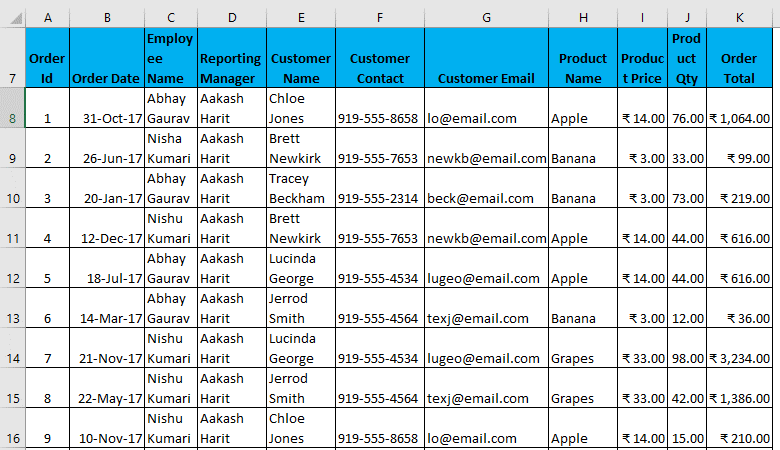
- Moreover, to make use of the advanced filter with the help of the various criteria as well as the condition, firstly, we need to make a copy of all the headers and then paste them somewhere else in the respectively available worksheet (But in this discussed example we will be making use of the blank rows to make this thing very much easier to understand. As clearly depicted in the below-attached screenshot.
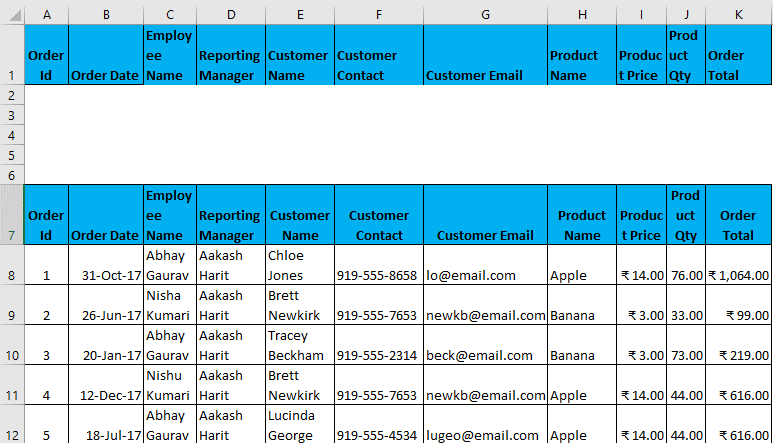
- Now, we will specify all the conditions under these particular headers according to our interest and the requirement to act efficiently as an input in the filter.
- Afterwards, we will select the entire dataset along with the headers and the GO-TO-Data Tab- Sort and filter. And doing these will effectively open the Advanced Dialogue box, as seen in the screenshot below.

- It then pressed the Hotkey to apply the respective advanced filter after selecting the dataset (Alt key + A +Q). As seen in the below-attached screenshot.
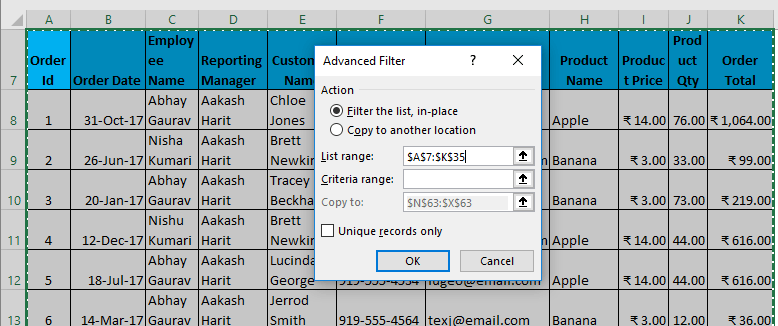
- Now from the above-attached screenshot, we need to enter the following details, as mentioned and discussed below:
- Action: The Actions options must need to have the two available options. And the first option is none other than the filter list in place (that will remove the original data, and then the outcome and the result of this particular filter will be effectively placed on the exact or actual locations). The Second option is to make a copy to another site (that will help an individual save the respective filtered data on the area effectively).
- List Range: The List range refers to the particular dataset from which we want to find the data efficiently.
- Criteria Range: The criteria need to be filled out effectively.
- Copy To: This cell will effectively be activated if an individual might go with the second option in the respective Action criteria.
- Copy Unique Records Only: Check this only if an individual will require the unique records only.
- I have entered all the precise details in this respective dialogue box, and then we will choose to copy them to the next location with the help of the unique records.
- After that, it will look somewhat as in the attached screenshot and then we will click on the "OK" button, effectively giving all the unique records.
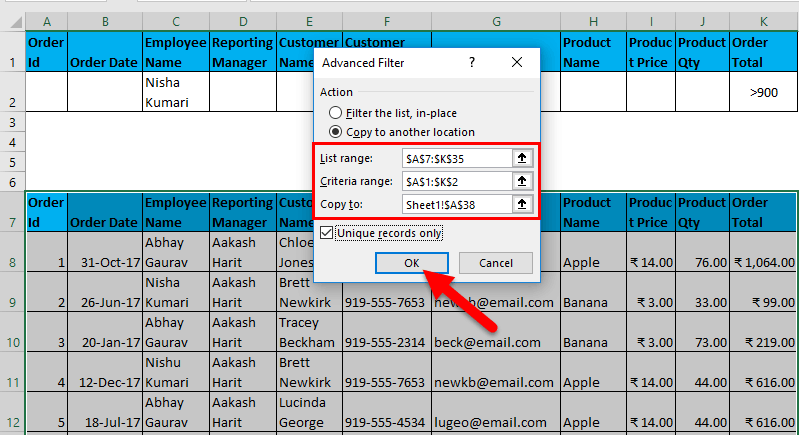
And the output is mentioned below, in which it could be shown that it wills only shows the data that contains the Employee name "Nishu Kumari." As seen in the below-attached screenshot respectively.
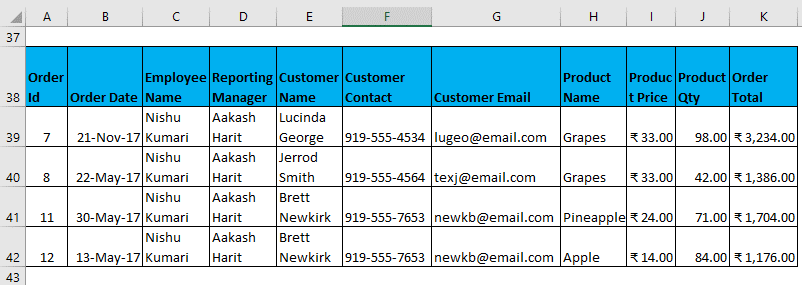
# Example 2: Advanced Filter in the Microsoft Excel
It was known that many of the combinations of the criteria could be used in the respective advanced filter (with the help of the AND as well as the OR criteria), so some of the examples related to it are as follows:
- In these, we will filter data in which the customer name is "Chloe Jones" And the product name is "Apple." As seen in the below-attached screenshot.

We have entered all the precise details in this dialogue box, and then we will choose to copy them to other effective locations with the help of the unique records, as seen in the below-attached screenshot.
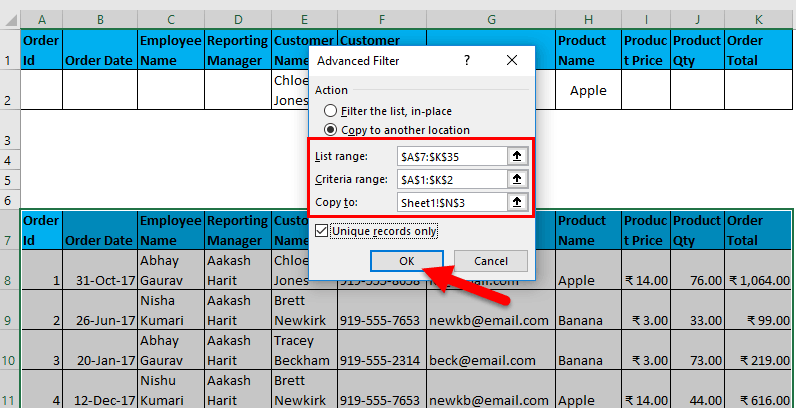
Therefore, the output for the above operation is as follows.

- Now, we will Filter the data where the respective Reporting Manager is the “Aakash Harit” AND the Product Quantity is greater than 50.

As it is seen, I have entered all the respective details in this particular dialogue box. Then we will choose to copy them to the individual other locations with the unique records effectively. As seen in the below-attached screenshot.
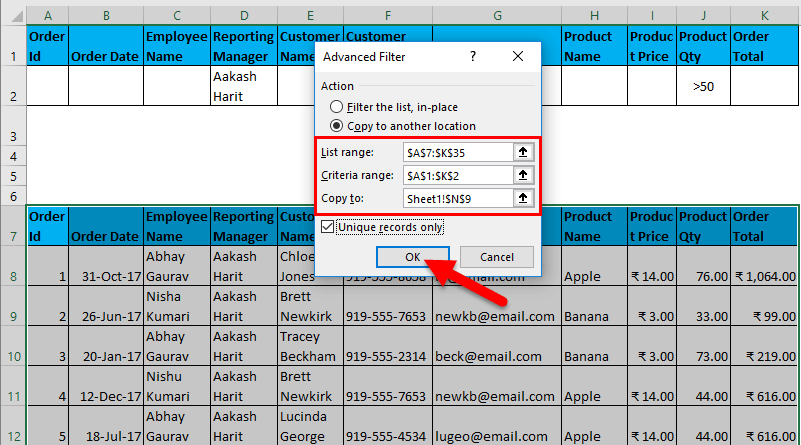
And the respective output for the above operations is efficiently mentioned in the below-attached screenshot.
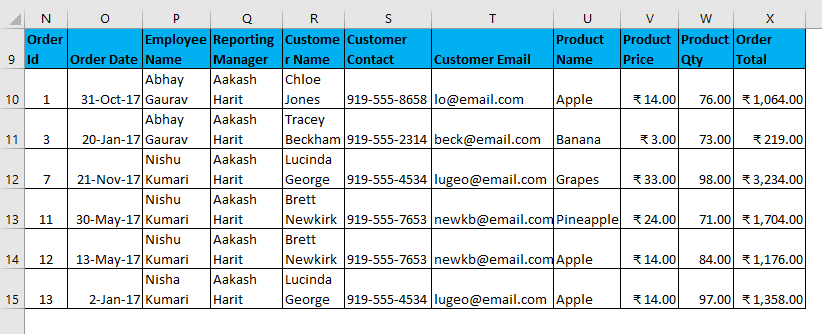
- Filter out the data where the name of the Employee is "Raj Kumar Singh" AND the Product Name is "Pineapple", AND the order total is more significant than 100.

In this, we have entered all the details in this particular dialogue box, and then we will choose to copy them to the other respective locations with the help of the unique records respectively.
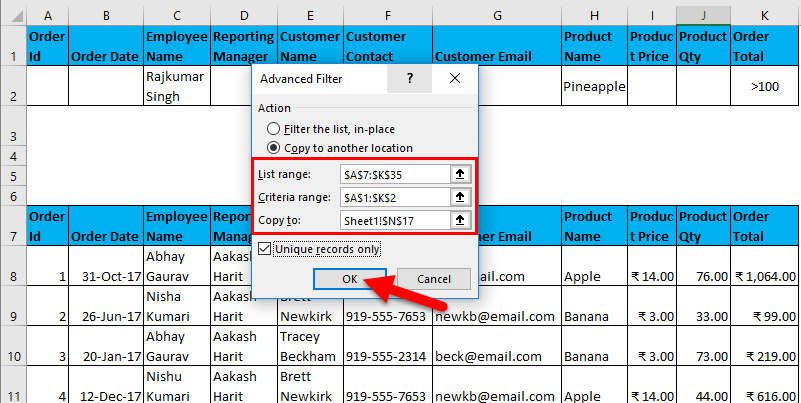
And the output for the above is seen in the below-attached screenshot effectively.
Moreover, the empty table shows the open data because it does not match the given condition.
- Filter out the data in which the Name of the Employee is “Vishal Kumar” OR The order total is primarily less than 500, as shown in the below-attached screenshot.

In this, we will enter the details effectively in this dialogue box and then choose to copy them to the other locations with the help of the unique records, as seen clearly in the screenshot below.
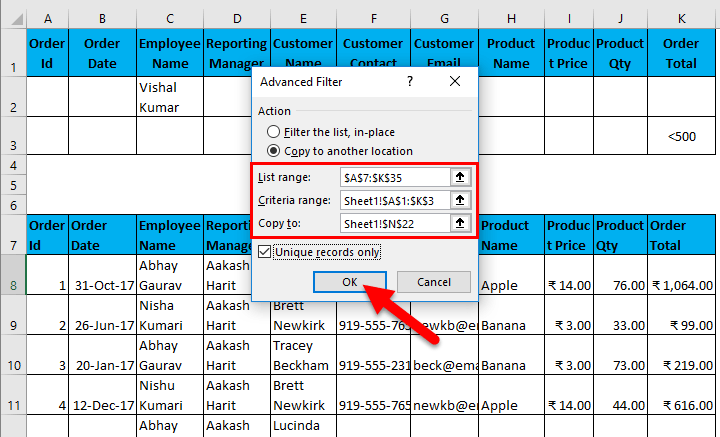
And the output for the above is seen in the below-mentioned figure.
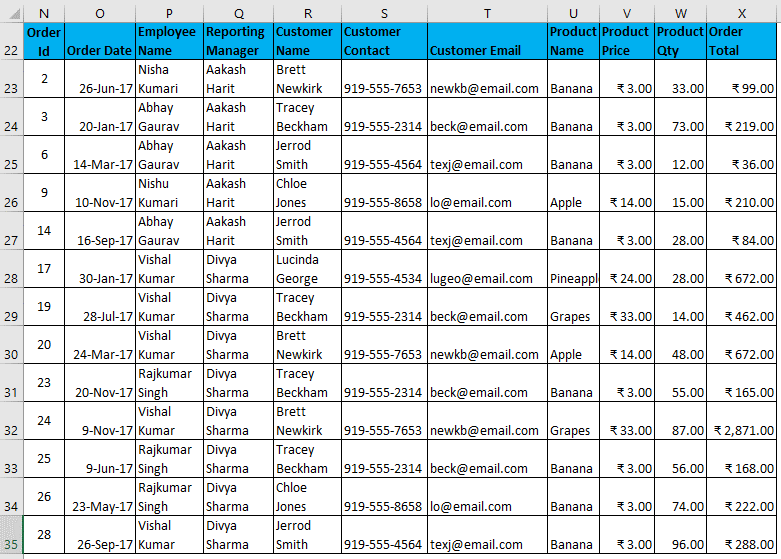
- Filter the data in which the name of the Employee is "Abhay Gaurav" OR "Nishu Kumari. As clearly depicted in the below-attached screenshot.

In this, we have entered all the respective details in this dialogue box, and then we will copy them to the other location with the help of the unique records effectively.
As seen in the below-attached screenshot.
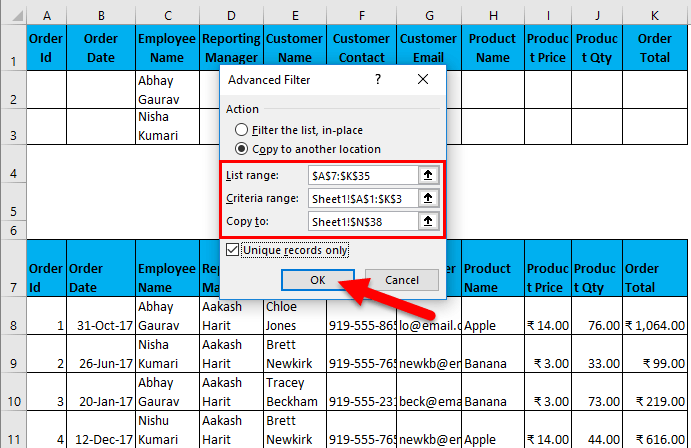
And the output for the above is mentioned in the below-attached screenshot.
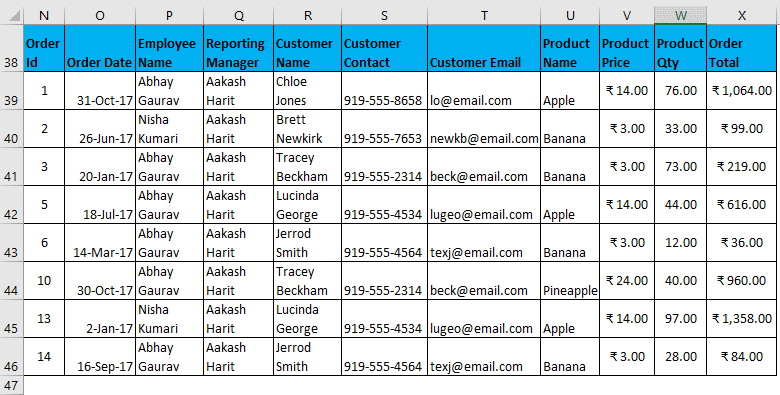
Things to Remember
The essential things that need to be remembered while working with the advanced filter in Microsoft Excel are as follows:
- It was assumed or known that the Advanced Filter is termed to be the advanced version of the regular filter that is used to filter out the data with the help of complex criteria as well as with multiple conditions as well.
- Furthermore, it can effectively extract the unique entries from the respective dataset.
- And Another essential thing that needs to be remembered by an individual is that an individual must be attentive in adding the headers while selecting the data set, and the respective titles in the criteria must be precisely in the same order as in the dataset effectively.
- In this, we cannot perform the " Undo " operation if the data filtration is basically copied to the other locations.
- And the effective shortcut to apply an advanced filter just after the selection of the dataset is none other than the (Alt key+A+Q).